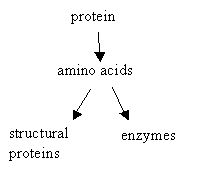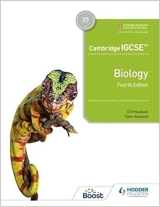Chapter 10. Food and diet
Page 87
1. a Milk, cheese, eggs, beans.
b Peas, beans, cereals (e.g. bread).
2. Proteins are needed to make cytoplasm and all the tissues of the body. They also make the enzymes needed for chemical changes in the cells.
3. In theory you could survive on proteins and lipids. Both these foodstuffs can be converted into energy which is normally provided by carbohydrates. You might be disadvantaged by a lack of dietary fibre and vitamin C (See p. 88).
4. When fats are oxidised they produce a large amount of energy, some of which is released in the form of heat. A layer of fat under the skin may have insulating properties and reduce loss of heat.
5. a Proteins contain nitrogen. Lipids do not.
b Proteins have about half the energy value of lipids.
c The principal use of proteins is to provide the amino acids needed for building other proteins in the cytoplasm of the cells which form the tissues of the body. They are also used to produce enzymes. Lipids are a means of storing energy.
6.

Page 89
1. a Red blood cells b All tissues c Bones and teeth d All cells e Thyroid gland.
2. (top left). Milk and its products such as cheese and yoghurt are good sources of proteins, lipids and calcium.
(top right) Most will contain some carbohydrate (e.g. banana), all will contain vitamins (e.g. tomato and orange, vitamin C. Green vegetables, vitamins A and C. Most of them will provide dietary fibre.
(bottom left) All will provide protein. The mackerel will contain lipids. The meat will provide iron.
(bottom right) Mainly carbohydrate, some B vitamins and dietary fibre.
3. Green vegetables such as cabbage and lettuce contain vitamin A and also dietary fibre.
4. A diet consisting of only one source of food is likely to be deficient in one or more essential minerals or vitamins.
5. Only a is likely to give meaningful results. The added Vitamin C of b and c is unlikely to demonstrate a need for Vitamin C even if the rabbits show some benefit. In d you would not know whether the outcome was due to lack of Vitamin C or some other property of the food. In fact, rabbits do not appear to need vitamin C, so the results of a confirm this.
Page 93
1. Proteins, carbohydrates and lipids, vitamins, mineral salts and water, a source of dietary fibre.
2. Protein cannot be stored in the body. If there is a large intake of protein, the body will take what it needs to build tissues and make enzymes and the remainder will be oxidised to provide energy which is a wasteful use of an important nutrient.
3. For all three, an adequate intake of protein is essential plus the calcium needed for the milk in the breast-feeding mother and the bone formation in the embryo and the growingchild.
4. a An apple has far less carbohydrate than a chocolate bar so it is unlikely to cause weight gain.
b A chocolate bar contains much more carbohydrate than an apple and will better meet your energy needs.
5. The fried potato (‘chips’) contains a good deal of fat which gives about twice the energy of the carbohydrate in boiled potato.
6. A high fibre diet will make you feel ‘full’ without taking in an excess of energy-rich food which can be converted to fat.
7. Hard physical work needs a great deal of energy which can be obtained best from carbohydrates and lipids.
8. See ‘Growing children’ on p.91. The text should have stated that the figures are ‘per day’ From these figures you would calculate that the baby needs 1.53 x 5 = 7.62 g of protein per day though there is little point in going to 2 decimal places. In fact 7.6 g seems too low for a 6 month baby. The text needs to be revised.
9. During sleep, only basal metabolism is taking place. If 8 hours sleep needs 2400 kJ, 24 hours basal metabolism would need 3 x 2400 = 72000 kJ. |
Downloads
Download the answers in PDF format below
Section 1, Chapters 1-5
Section 2, Chapters 6-9
Section 3, Chapters 10-12
Section 3, Chapters 13-17
Section 3, Chapters 18-20
Section 4, Chapters 21-24
Section 5, Chapters 25-27
Section 5, Chapters 28-29
Section 6, Chapters 30-34
Section 6, Chapters 35-37
Section 7, Chapters 38-39
Section 8, Chapters 40-41
|

